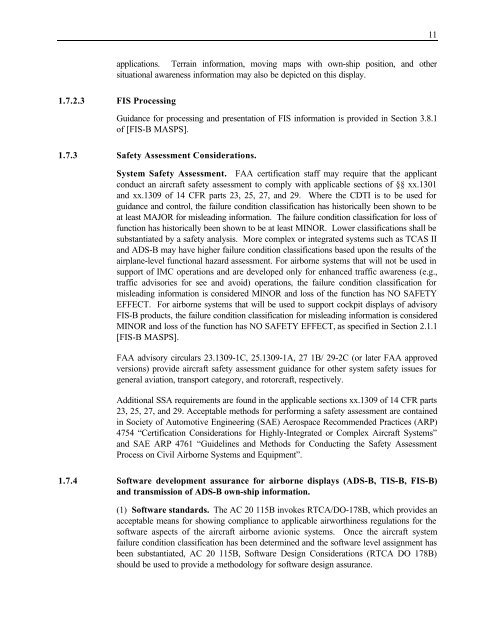Interim Guidance for UAT Avionics Operating with Safe Flight 21 ...
Interim Guidance for UAT Avionics Operating with Safe Flight 21 ...
Interim Guidance for UAT Avionics Operating with Safe Flight 21 ...
You also want an ePaper? Increase the reach of your titles
YUMPU automatically turns print PDFs into web optimized ePapers that Google loves.
applications. Terrain in<strong>for</strong>mation, moving maps <strong>with</strong> own-ship position, and other<br />
situational awareness in<strong>for</strong>mation may also be depicted on this display.<br />
1.7.2.3 FIS Processing<br />
<strong>Guidance</strong> <strong>for</strong> processing and presentation of FIS in<strong>for</strong>mation is provided in Section 3.8.1<br />
of [FIS-B MASPS].<br />
1.7.3 <strong>Safe</strong>ty Assessment Considerations.<br />
System <strong>Safe</strong>ty Assessment. FAA certification staff may require that the applicant<br />
conduct an aircraft safety assessment to comply <strong>with</strong> applicable sections of §§ xx.1301<br />
and xx.1309 of 14 CFR parts 23, 25, 27, and 29. Where the CDTI is to be used <strong>for</strong><br />
guidance and control, the failure condition classification has historically been shown to be<br />
at least MAJOR <strong>for</strong> misleading in<strong>for</strong>mation. The failure condition classification <strong>for</strong> loss of<br />
function has historically been shown to be at least MINOR. Lower classifications shall be<br />
substantiated by a safety analysis. More complex or integrated systems such as TCAS II<br />
and ADS-B may have higher failure condition classifications based upon the results of the<br />
airplane-level functional hazard assessment. For airborne systems that will not be used in<br />
support of IMC operations and are developed only <strong>for</strong> enhanced traffic awareness (e.g.,<br />
traffic advisories <strong>for</strong> see and avoid) operations, the failure condition classification <strong>for</strong><br />
misleading in<strong>for</strong>mation is considered MINOR and loss of the function has NO SAFETY<br />
EFFECT. For airborne systems that will be used to support cockpit displays of advisory<br />
FIS-B products, the failure condition classification <strong>for</strong> misleading in<strong>for</strong>mation is considered<br />
MINOR and loss of the function has NO SAFETY EFFECT, as specified in Section 2.1.1<br />
[FIS-B MASPS].<br />
FAA advisory circulars 23.1309-1C, 25.1309-1A, 27 1B/ 29-2C (or later FAA approved<br />
versions) provide aircraft safety assessment guidance <strong>for</strong> other system safety issues <strong>for</strong><br />
general aviation, transport category, and rotorcraft, respectively.<br />
Additional SSA requirements are found in the applicable sections xx.1309 of 14 CFR parts<br />
23, 25, 27, and 29. Acceptable methods <strong>for</strong> per<strong>for</strong>ming a safety assessment are contained<br />
in Society of Automotive Engineering (SAE) Aerospace Recommended Practices (ARP)<br />
4754 “Certification Considerations <strong>for</strong> Highly-Integrated or Complex Aircraft Systems”<br />
and SAE ARP 4761 “Guidelines and Methods <strong>for</strong> Conducting the <strong>Safe</strong>ty Assessment<br />
Process on Civil Airborne Systems and Equipment”.<br />
1.7.4 Software development assurance <strong>for</strong> airborne displays (ADS-B, TIS-B, FIS-B)<br />
and transmission of ADS-B own-ship in<strong>for</strong>mation.<br />
(1) Software standards. The AC 20 115B invokes RTCA/DO-178B, which provides an<br />
acceptable means <strong>for</strong> showing compliance to applicable airworthiness regulations <strong>for</strong> the<br />
software aspects of the aircraft airborne avionic systems. Once the aircraft system<br />
failure condition classification has been determined and the software level assignment has<br />
been substantiated, AC 20 115B, Software Design Considerations (RTCA DO 178B)<br />
should be used to provide a methodology <strong>for</strong> software design assurance.<br />
11
















